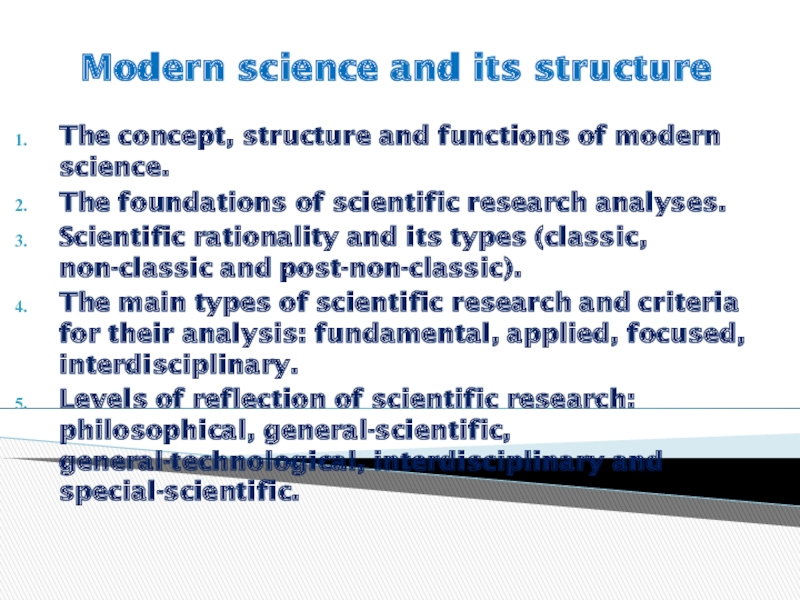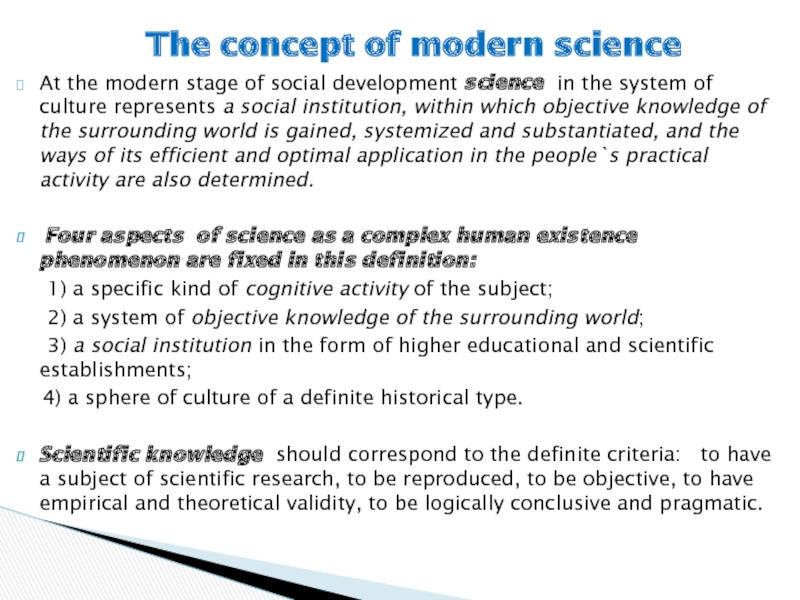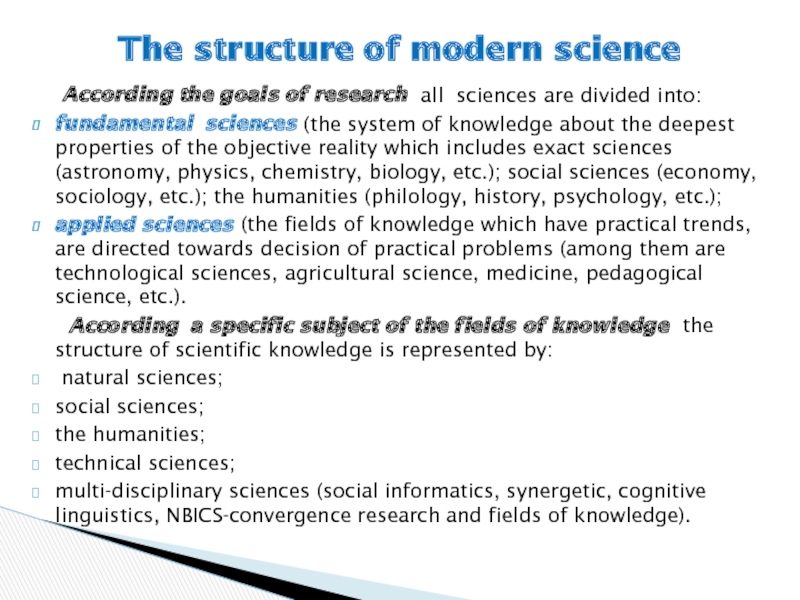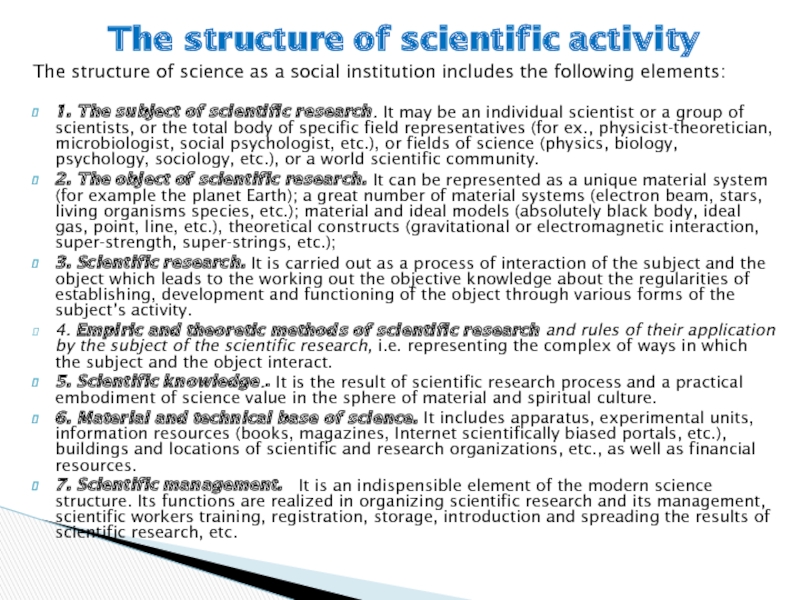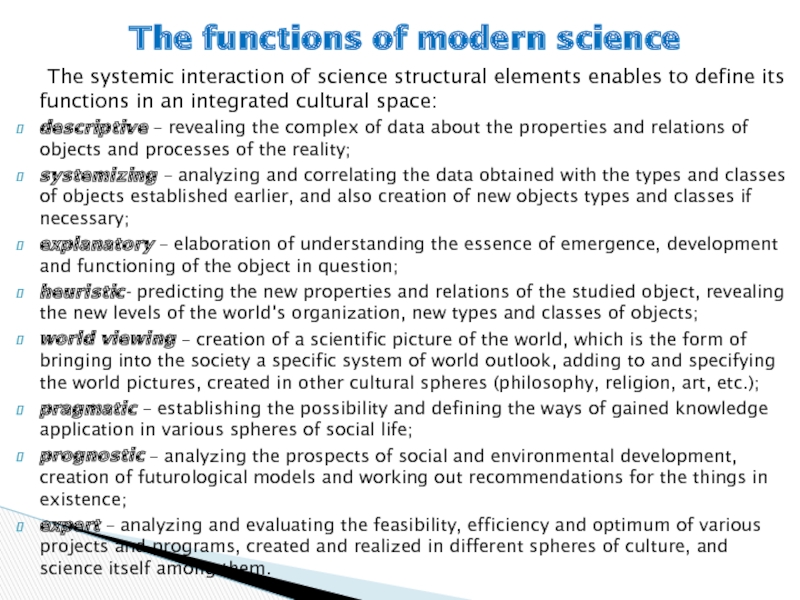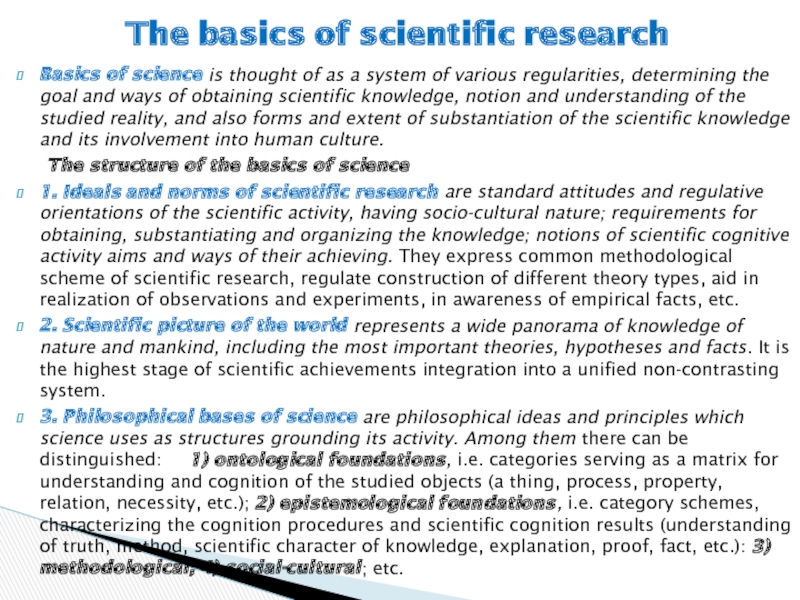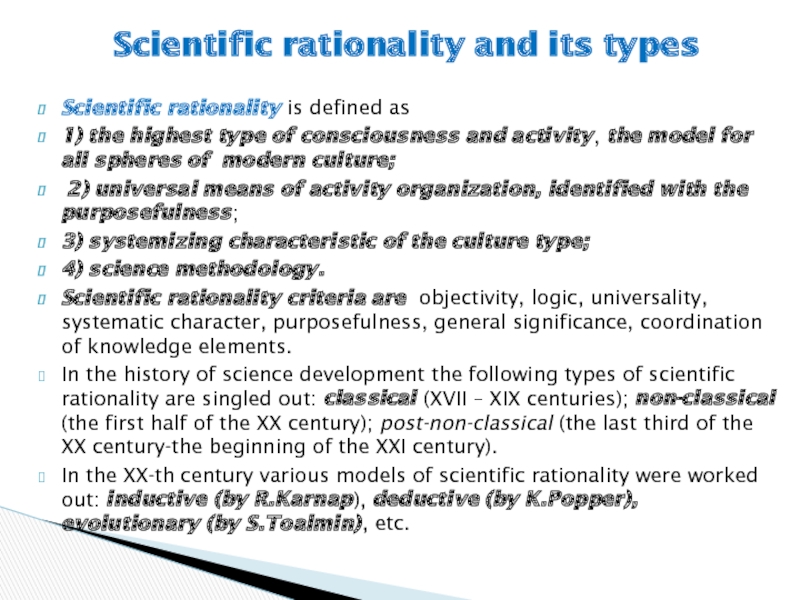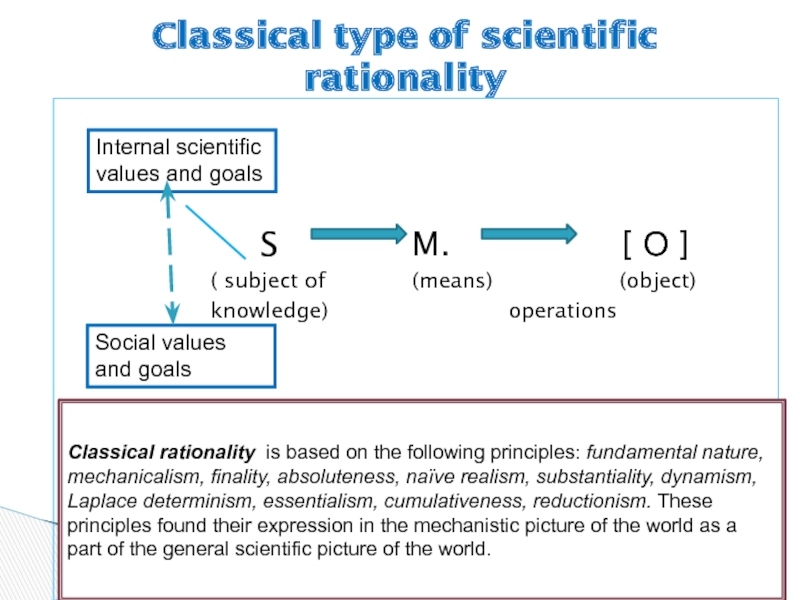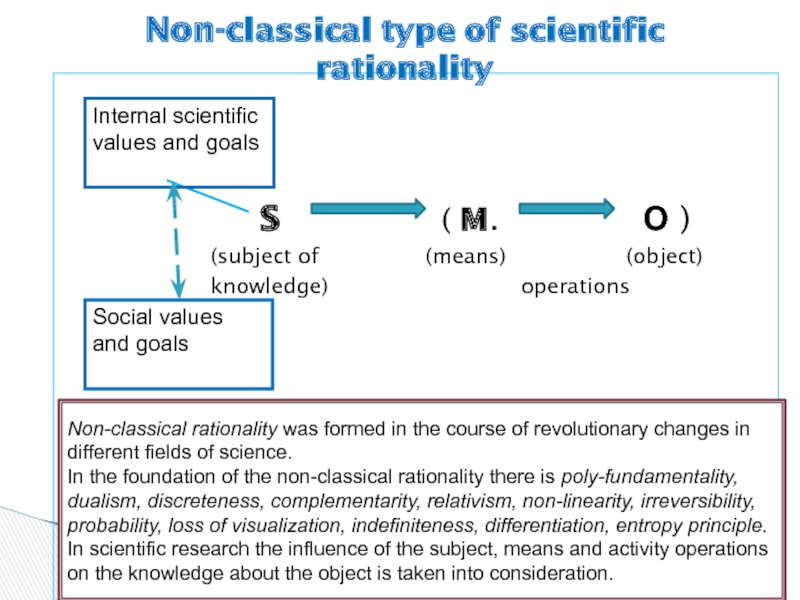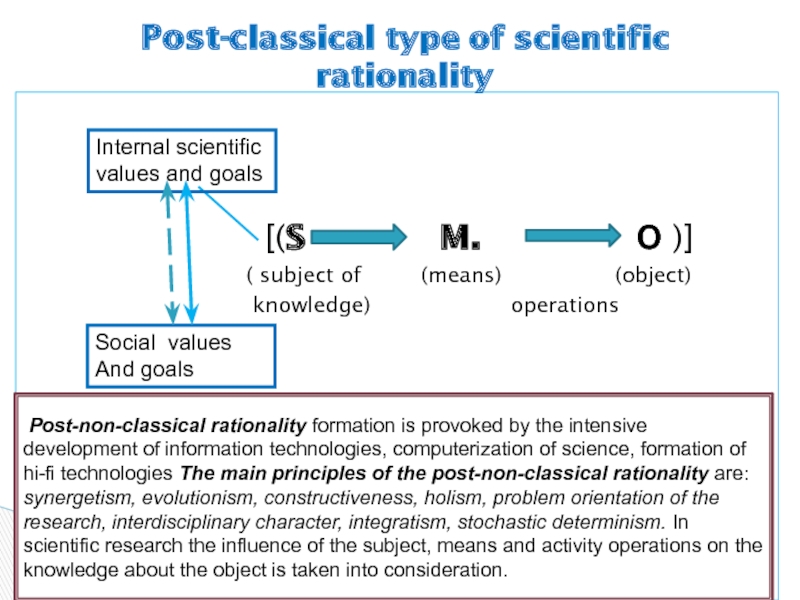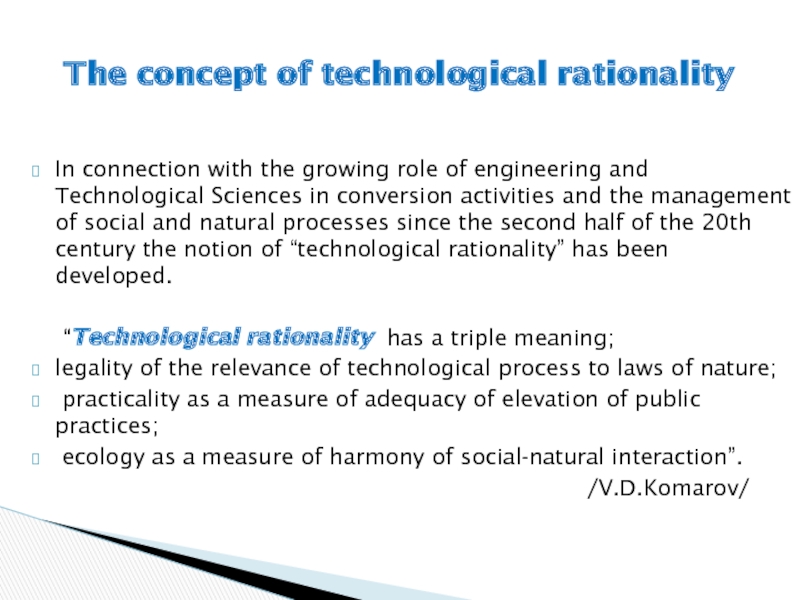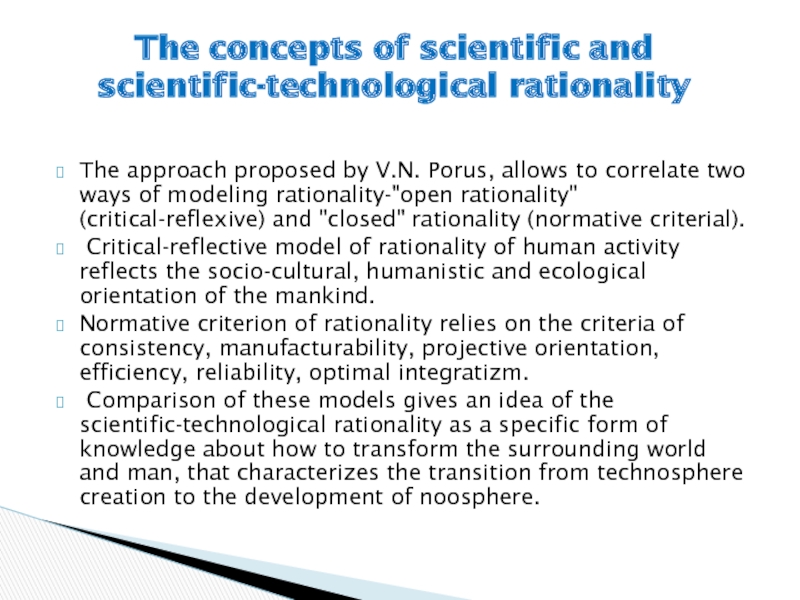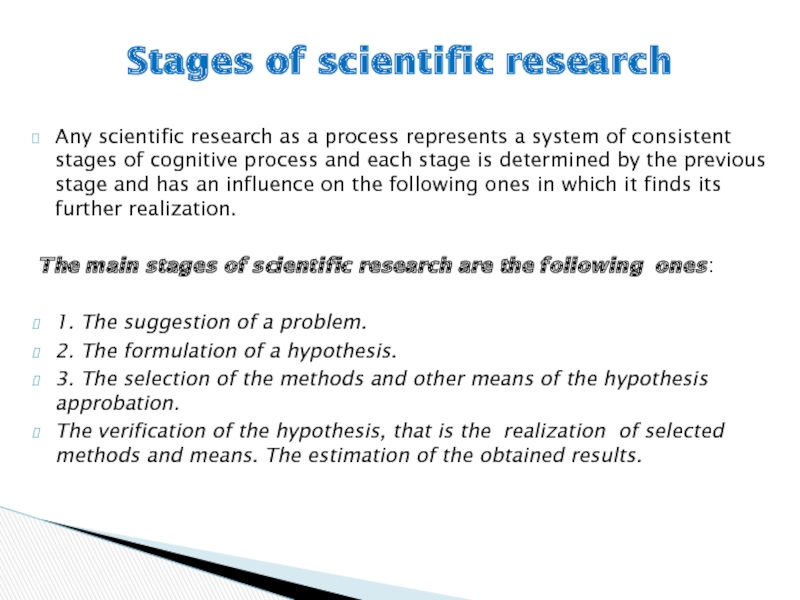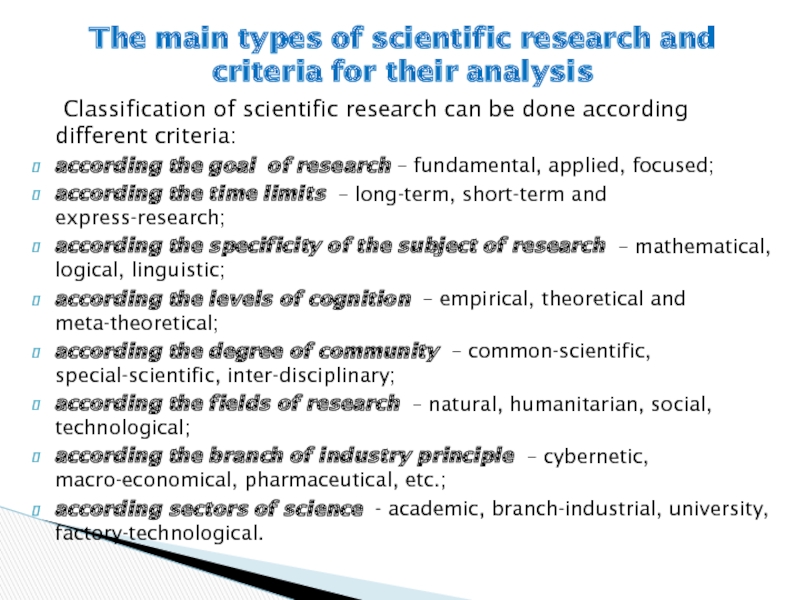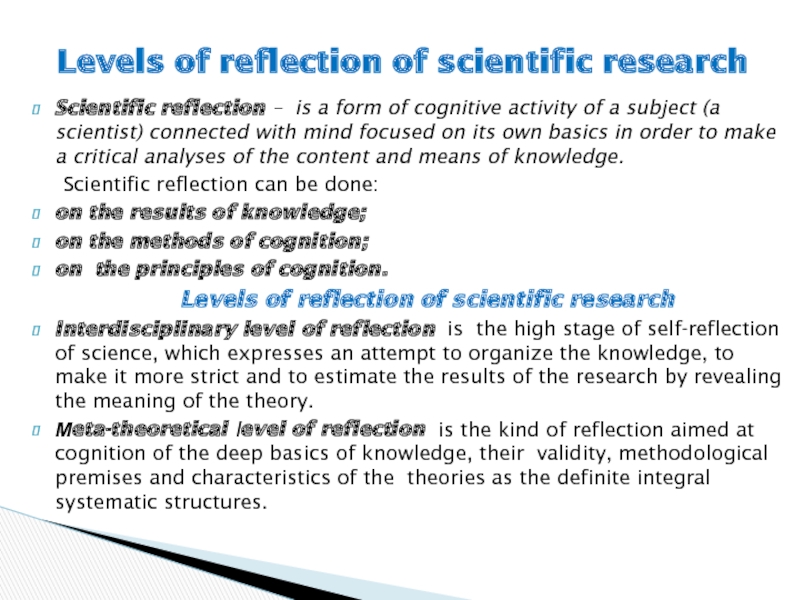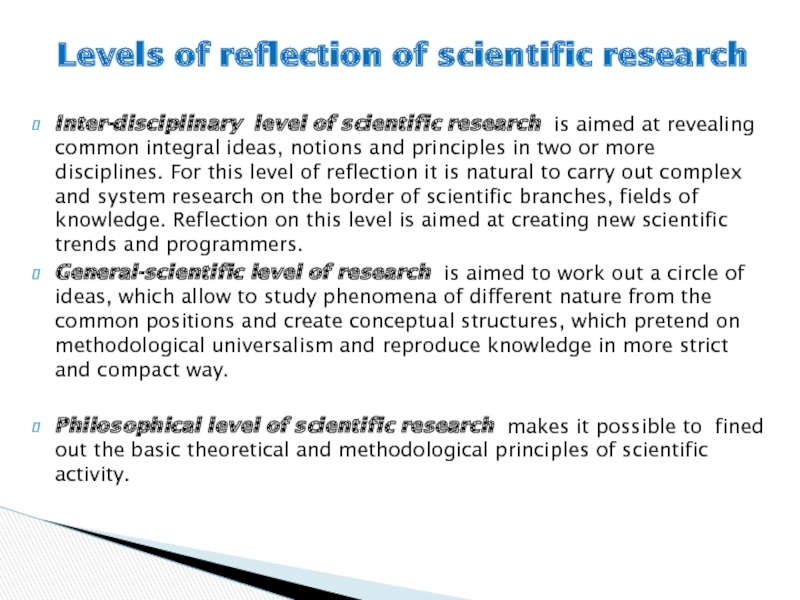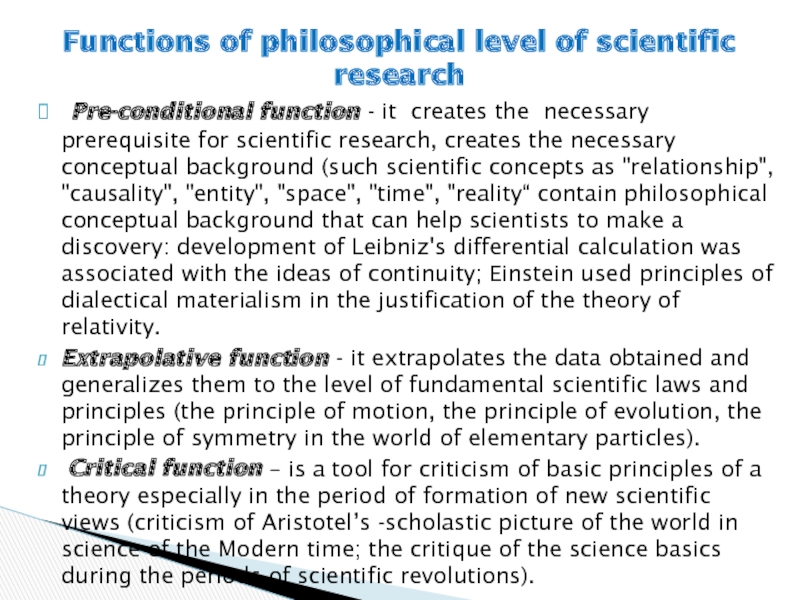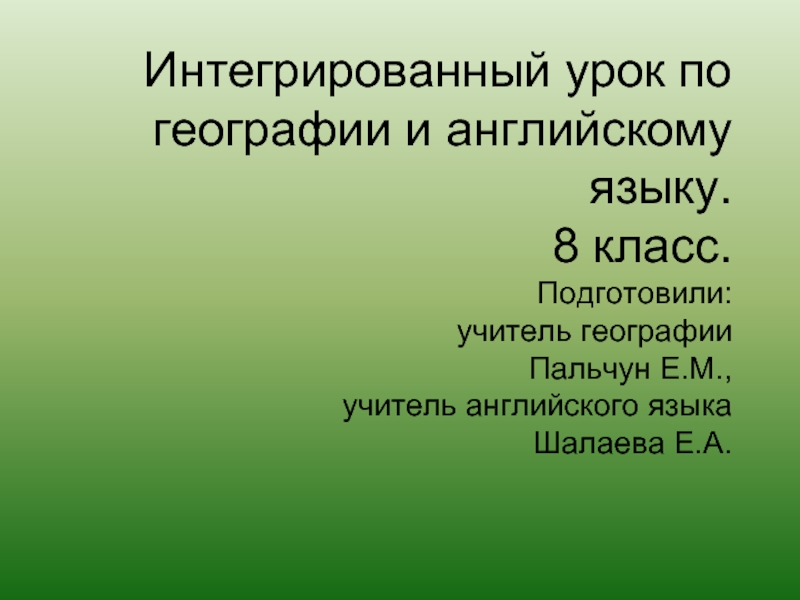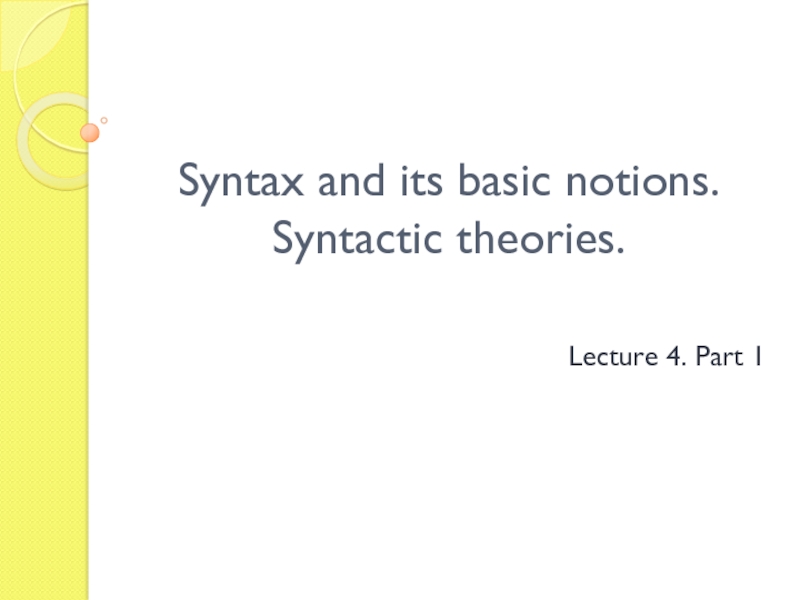- Главная
- Разное
- Дизайн
- Бизнес и предпринимательство
- Аналитика
- Образование
- Развлечения
- Красота и здоровье
- Финансы
- Государство
- Путешествия
- Спорт
- Недвижимость
- Армия
- Графика
- Культурология
- Еда и кулинария
- Лингвистика
- Английский язык
- Астрономия
- Алгебра
- Биология
- География
- Детские презентации
- Информатика
- История
- Литература
- Маркетинг
- Математика
- Медицина
- Менеджмент
- Музыка
- МХК
- Немецкий язык
- ОБЖ
- Обществознание
- Окружающий мир
- Педагогика
- Русский язык
- Технология
- Физика
- Философия
- Химия
- Шаблоны, картинки для презентаций
- Экология
- Экономика
- Юриспруденция
Modern science and its structure презентация
Содержание
- 1. Modern science and its structure
- 2. At the modern stage of social development
- 3. According the goals of research all sciences
- 4. The structure of science as a social
- 5. The systemic interaction of science structural elements
- 6. Basics of science is thought of as
- 7. Scientific rationality is defined as 1)
- 11. In connection with the growing role
- 12. The approach proposed by V.N. Porus,
- 13. Any scientific research as a process
- 14. Classification of scientific research can be done
- 15. Scientific reflection – is a form of
- 16. Inter-disciplinary level of scientific research is
- 17. Pre-conditional function - it creates the
- 18. Heuristic function - heuristic tool is an
- 19. 1. Theoretical Knowledge by VYACHESLAV STEPIN
Слайд 1Modern science and its structure
The concept, structure and functions of modern
The foundations of scientific research analyses.
Scientific rationality and its types (classic, non-classic and post-non-classic).
The main types of scientific research and criteria for their analysis: fundamental, applied, focused, interdisciplinary.
Levels of reflection of scientific research: philosophical, general-scientific, general-technological, interdisciplinary and special-scientific.
Слайд 2At the modern stage of social development science in the system
Four aspects of science as a complex human existence phenomenon are fixed in this definition:
1) a specific kind of cognitive activity of the subject;
2) a system of objective knowledge of the surrounding world;
3) a social institution in the form of higher educational and scientific establishments;
4) a sphere of culture of a definite historical type.
Scientific knowledge should correspond to the definite criteria: to have a subject of scientific research, to be reproduced, to be objective, to have empirical and theoretical validity, to be logically conclusive and pragmatic.
The concept of modern science
Слайд 3 According the goals of research all sciences are divided into:
fundamental
applied sciences (the fields of knowledge which have practical trends, are directed towards decision of practical problems (among them are technological sciences, agricultural science, medicine, pedagogical science, etc.).
According a specific subject of the fields of knowledge the structure of scientific knowledge is represented by:
natural sciences;
social sciences;
the humanities;
technical sciences;
multi-disciplinary sciences (social informatics, synergetic, cognitive linguistics, NBICS-convergence research and fields of knowledge).
The structure of modern science
Слайд 4The structure of science as a social institution includes the following
1. The subject of scientific research. It may be an individual scientist or a group of scientists, or the total body of specific field representatives (for ex., physicist-theoretician, microbiologist, social psychologist, etc.), or fields of science (physics, biology, psychology, sociology, etc.), or a world scientific community.
2. The object of scientific research. It can be represented as a unique material system (for example the planet Earth); a great number of material systems (electron beam, stars, living organisms species, etc.); material and ideal models (absolutely black body, ideal gas, point, line, etc.), theoretical constructs (gravitational or electromagnetic interaction, super-strength, super-strings, etc.);
3. Scientific research. It is carried out as a process of interaction of the subject and the object which leads to the working out the objective knowledge about the regularities of establishing, development and functioning of the object through various forms of the subject’s activity.
4. Empiric and theoretic methods of scientific research and rules of their application by the subject of the scientific research, i.e. representing the complex of ways in which the subject and the object interact.
5. Scientific knowledge.. It is the result of scientific research process and a practical embodiment of science value in the sphere of material and spiritual culture.
6. Material and technical base of science. It includes apparatus, experimental units, information resources (books, magazines, Internet scientifically biased portals, etc.), buildings and locations of scientific and research organizations, etc., as well as financial resources.
7. Scientific management. It is an indispensible element of the modern science structure. Its functions are realized in organizing scientific research and its management, scientific workers training, registration, storage, introduction and spreading the results of scientific research, etc.
The structure of scientific activity
Слайд 5 The systemic interaction of science structural elements enables to define its
descriptive – revealing the complex of data about the properties and relations of objects and processes of the reality;
systemizing – analyzing and correlating the data obtained with the types and classes of objects established earlier, and also creation of new objects types and classes if necessary;
explanatory – elaboration of understanding the essence of emergence, development and functioning of the object in question;
heuristic- predicting the new properties and relations of the studied object, revealing the new levels of the world’s organization, new types and classes of objects;
world viewing – creation of a scientific picture of the world, which is the form of bringing into the society a specific system of world outlook, adding to and specifying the world pictures, created in other cultural spheres (philosophy, religion, art, etc.);
pragmatic – establishing the possibility and defining the ways of gained knowledge application in various spheres of social life;
prognostic – analyzing the prospects of social and environmental development, creation of futurological models and working out recommendations for the things in existence;
expert – analyzing and evaluating the feasibility, efficiency and optimum of various projects and programs, created and realized in different spheres of culture, and science itself among them.
The functions of modern science
Слайд 6Basics of science is thought of as a system of various
The structure of the basics of science
1. Ideals and norms of scientific research are standard attitudes and regulative orientations of the scientific activity, having socio-cultural nature; requirements for obtaining, substantiating and organizing the knowledge; notions of scientific cognitive activity aims and ways of their achieving. They express common methodological scheme of scientific research, regulate construction of different theory types, aid in realization of observations and experiments, in awareness of empirical facts, etc.
2. Scientific picture of the world represents a wide panorama of knowledge of nature and mankind, including the most important theories, hypotheses and facts. It is the highest stage of scientific achievements integration into a unified non-contrasting system.
3. Philosophical bases of science are philosophical ideas and principles which science uses as structures grounding its activity. Among them there can be distinguished: 1) ontological foundations, i.e. categories serving as a matrix for understanding and cognition of the studied objects (a thing, process, property, relation, necessity, etc.); 2) epistemological foundations, i.e. category schemes, characterizing the cognition procedures and scientific cognition results (understanding of truth, method, scientific character of knowledge, explanation, proof, fact, etc.): 3) methodological; 4) social-cultural; etc.
The basics of scientific research
Слайд 7Scientific rationality is defined as
1) the highest type of consciousness
2) universal means of activity organization, identified with the purposefulness;
3) systemizing characteristic of the culture type;
4) science methodology.
Scientific rationality criteria are objectivity, logic, universality, systematic character, purposefulness, general significance, coordination of knowledge elements.
In the history of science development the following types of scientific rationality are singled out: classical (XVII – XIX centuries); non-classical (the first half of the XX century); post-non-classical (the last third of the XX century-the beginning of the XXI century).
In the XX-th century various models of scientific rationality were worked out: inductive (by R.Karnap), deductive (by K.Popper), evolutionary (by S.Toalmin), etc.
Scientific rationality and its types
Слайд 8
S M. [ О ]
( subject of (means) (object)
knowledge) operations
Classical type of scientific rationality
Social values and goals
Internal scientific
values and goals
Classical rationality is based on the following principles: fundamental nature, mechanicalism, finality, absoluteness, naïve realism, substantiality, dynamism, Laplace determinism, essentialism, cumulativeness, reductionism. These principles found their expression in the mechanistic picture of the world as a part of the general scientific picture of the world.
Слайд 9
S ( M. О )
(subject of (means) (object)
knowledge) оperations
Non-classical type of scientific rationality
Social values and goals
Internal scientific
values and goals
Non-classical rationality was formed in the course of revolutionary changes in different fields of science.
In the foundation of the non-classical rationality there is poly-fundamentality, dualism, discreteness, complementarity, relativism, non-linearity, irreversibility, probability, loss of visualization, indefiniteness, differentiation, entropy principle. In scientific research the influence of the subject, means and activity operations on the knowledge about the object is taken into consideration.
Слайд 10
[(S M. О )]
( subject of (means) (оbject)
knowledge) operations
Post-classical type of scientific rationality
Social values
And goals
Internal scientific values and goals
Post-non-classical rationality formation is provoked by the intensive development of information technologies, computerization of science, formation of hi-fi technologies The main principles of the post-non-classical rationality are: synergetism, evolutionism, constructiveness, holism, problem orientation of the research, interdisciplinary character, integratism, stochastic determinism. In scientific research the influence of the subject, means and activity operations on the knowledge about the object is taken into consideration.
Слайд 11
In connection with the growing role of engineering and Technological Sciences
“Technological rationality has a triple meaning;
legality of the relevance of technological process to laws of nature;
practicality as a measure of adequacy of elevation of public practices;
ecology as a measure of harmony of social-natural interaction”.
/V.D.Komarov/
The concept of technological rationality
Слайд 12
The approach proposed by V.N. Porus, allows to correlate two ways
Critical-reflective model of rationality of human activity reflects the socio-cultural, humanistic and ecological orientation of the mankind.
Normative criterion of rationality relies on the criteria of consistency, manufacturability, projective orientation, efficiency, reliability, optimal integratizm.
Comparison of these models gives an idea of the scientific-technological rationality as a specific form of knowledge about how to transform the surrounding world and man, that characterizes the transition from technosphere creation to the development of noosphere.
The concepts of scientific and scientific-technological rationality
Слайд 13
Any scientific research as a process represents a system of consistent
The main stages of scientific research are the following ones:
1. The suggestion of a problem.
2. The formulation of a hypothesis.
3. The selection of the methods and other means of the hypothesis approbation.
The verification of the hypothesis, that is the realization of selected methods and means. The estimation of the obtained results.
Stages of scientific research
Слайд 14 Classification of scientific research can be done according different criteria:
according the
according the time limits – long-term, short-term and express-research;
according the specificity of the subject of research – mathematical, logical, linguistic;
according the levels of cognition – empirical, theoretical and meta-theoretical;
according the degree of community – common-scientific, special-scientific, inter-disciplinary;
according the fields of research – natural, humanitarian, social, technological;
according the branch of industry principle – cybernetic, macro-economical, pharmaceutical, etc.;
according sectors of science - academic, branch-industrial, university, factory-technological.
The main types of scientific research and criteria for their analysis
Слайд 15Scientific reflection – is a form of cognitive activity of a
Scientific reflection can be done:
on the results of knowledge;
on the methods of cognition;
on the principles of cognition.
Levels of reflection of scientific research
Interdisciplinary level of reflection is the high stage of self-reflection of science, which expresses an attempt to organize the knowledge, to make it more strict and to estimate the results of the research by revealing the meaning of the theory.
Мeta-theoretical level of reflection is the kind of reflection aimed at cognition of the deep basics of knowledge, their validity, methodological premises and characteristics of the theories as the definite integral systematic structures.
Levels of reflection of scientific research
Слайд 16
Inter-disciplinary level of scientific research is aimed at revealing common integral
General-scientific level of research is aimed to work out a circle of ideas, which allow to study phenomena of different nature from the common positions and create conceptual structures, which pretend on methodological universalism and reproduce knowledge in more strict and compact way.
Philosophical level of scientific research makes it possible to fined out the basic theoretical and methodological principles of scientific activity.
Levels of reflection of scientific research
Слайд 17 Pre-conditional function - it creates the necessary prerequisite for scientific
Extrapolative function - it extrapolates the data obtained and generalizes them to the level of fundamental scientific laws and principles (the principle of motion, the principle of evolution, the principle of symmetry in the world of elementary particles).
Critical function – is a tool for criticism of basic principles of a theory especially in the period of formation of new scientific views (criticism of Aristotel’s -scholastic picture of the world in science of the Modern time; the critique of the science basics during the periods of scientific revolutions).
Functions of philosophical level of scientific research
Слайд 18Heuristic function - heuristic tool is an important supplier of valuable
Clarifying function means clarifying the content of the bases of scientific knowledge, the nature of scientific activities, promoting science cognition its own bases.
Interpret –communicative function means interpretation of scientific results and mediating the interdisciplinary dialogue between different areas of knowledge, it helps to bridge the gap between science and the humanities, as well as carry the dialogue of science with the public.
The axiological-ethical function means value comprehending of the relations associated with the scientific activities (scientific problems of ethos of science; scientific knowledge is not free from values as regulators of scientific activities).
Functions of philosophical level of scientific research
Слайд 19
1. Theoretical Knowledge by VYACHESLAV STEPIN Russian Academy of Science, Moscow,
SYNTHESE LIBRARY. STUDIES IN EPISTEMOLOGY, LOGIC, METHODOLOGY, AND PHILOSOPHY OF SCIENCE. VOLUME 326.
Published by Springer, U.S.A.
www.springeronline.com
Literature on the topic
